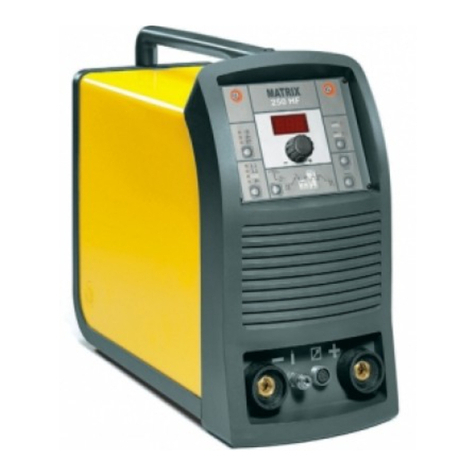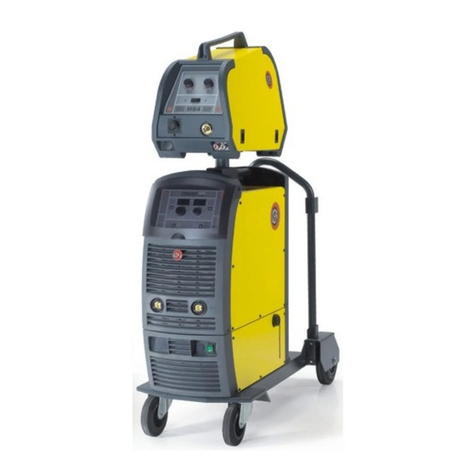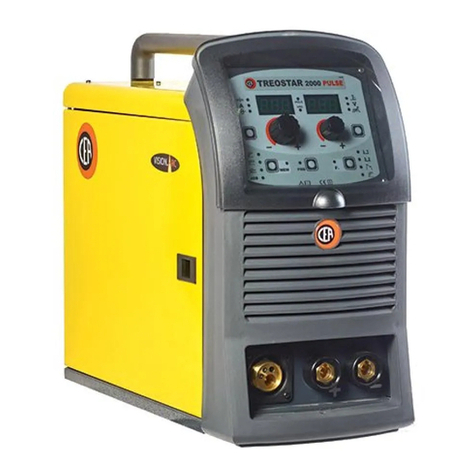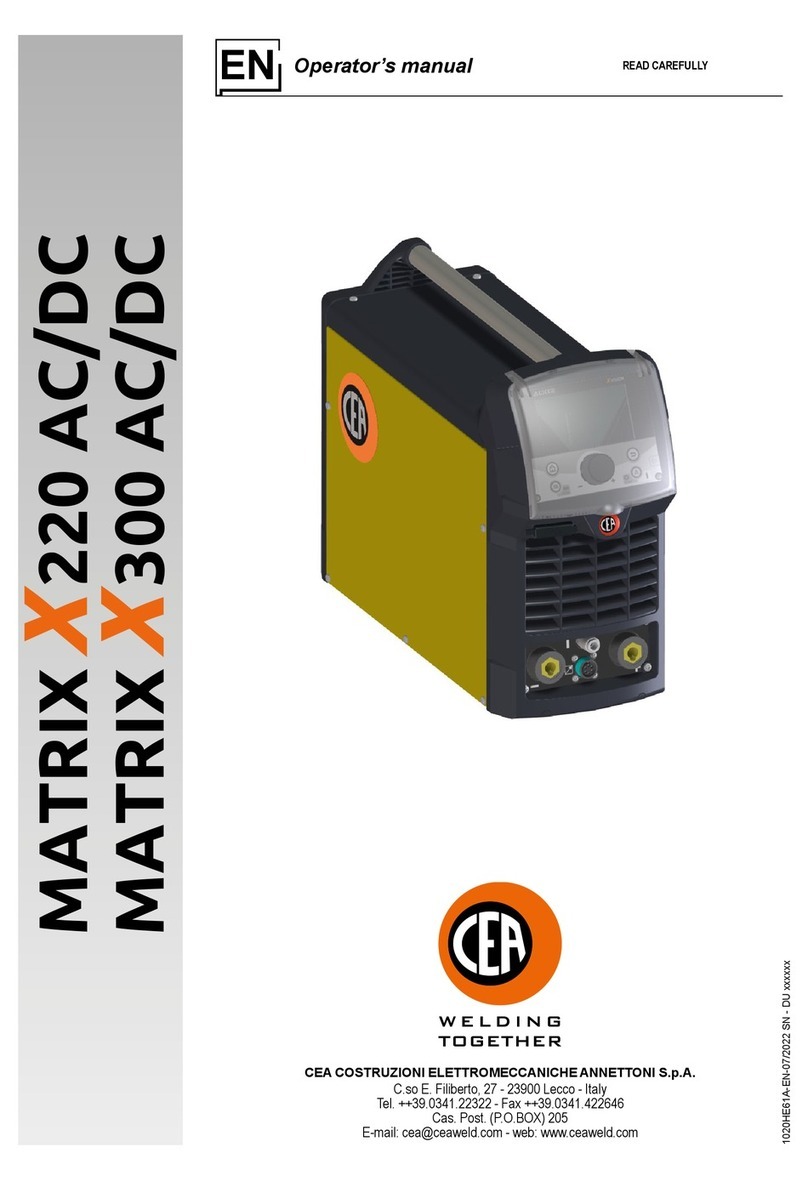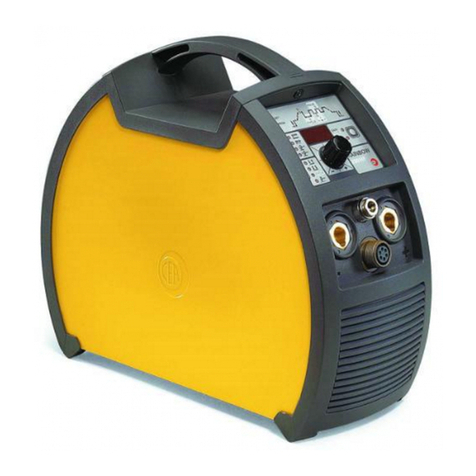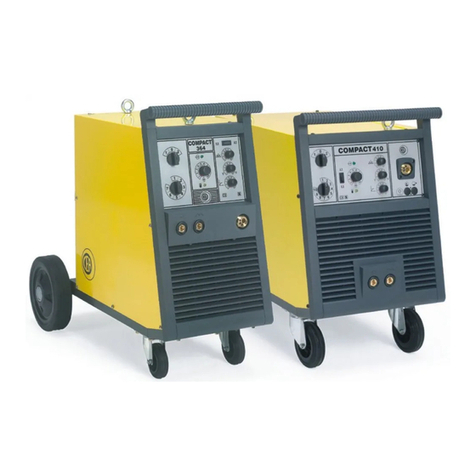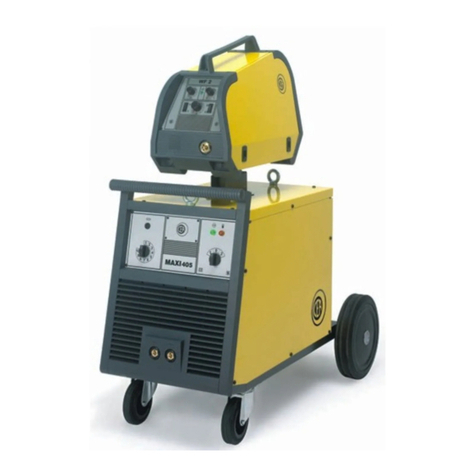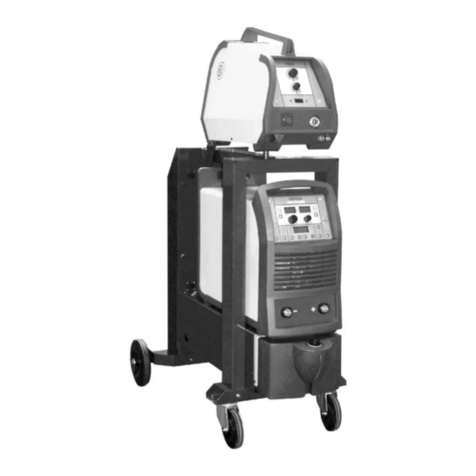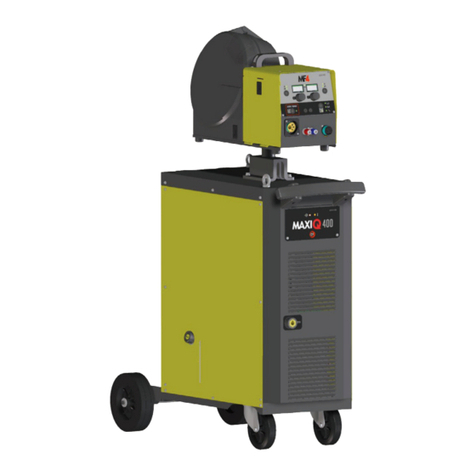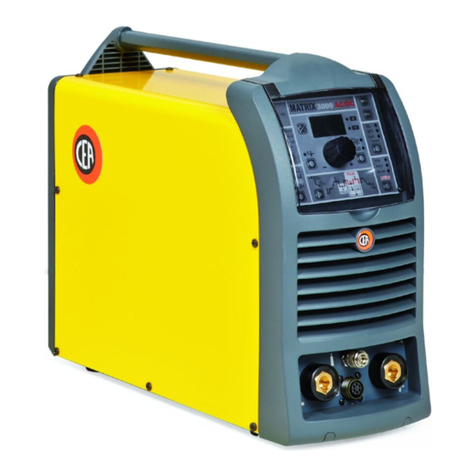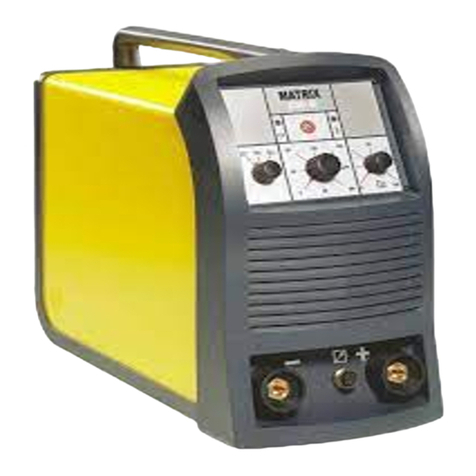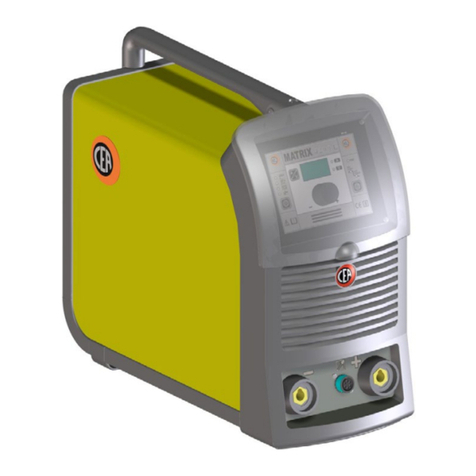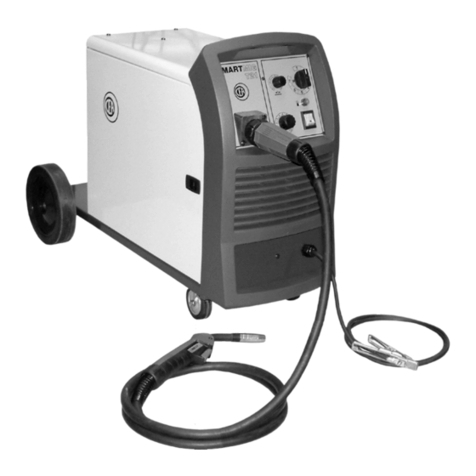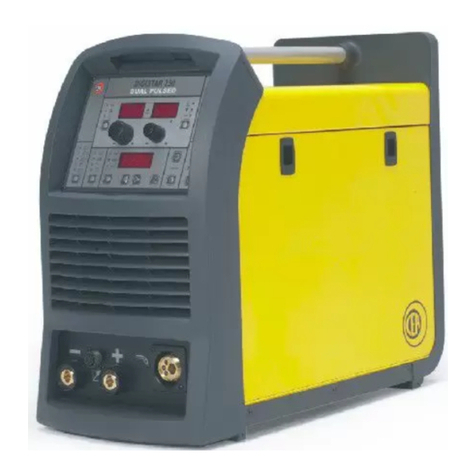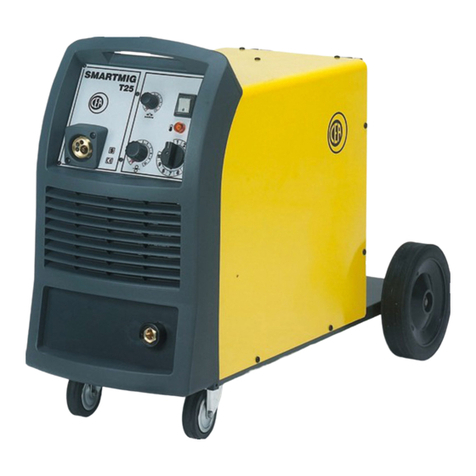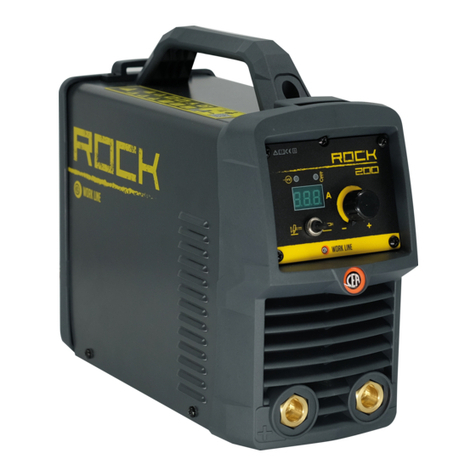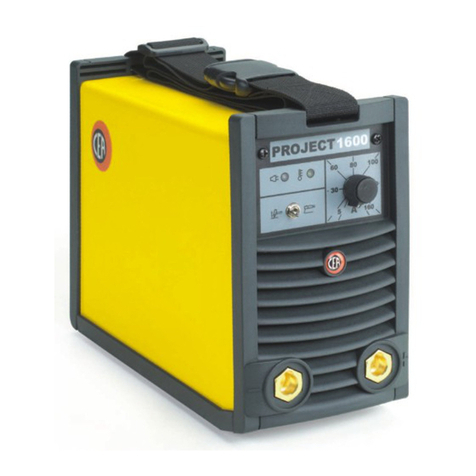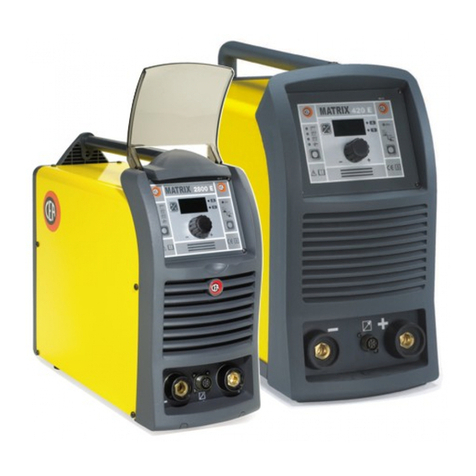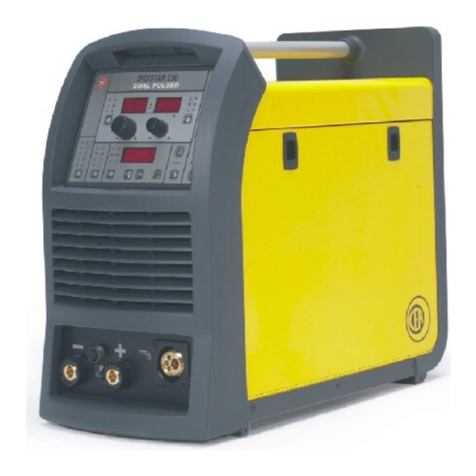
11
Pos. 8 Yellow thermostat protection LED. This LED lights up
when the overheating protection trips.You are work-
ing beyond the work cycle (see “Limits of use”). Wait
a few minutes before continuing the welding.
Pos. 9
Welding voltage selection switch.
Pos. 10
Centralized torch connection.
Pos. 11
Snap-in connector for ground line.
Connection of torch and ground wire
• Connect the rear end of the welding torch to the centralized
connector on the front panel (Pos. 10, Fig. D).
•
Insert the ground wire in the snap connectors(Pos. 11,
Fig. D).
Loading wire
•
Open the moving part of the cover and fit the coil (Ø 300
mm) onto the support in such a way that the wire unwinds in
a clockwise direction and centres the projecting reference of
the support with the matching hole in the coil.
•
Thread the end of the wire into the back guide (Pos. 1, Fig. E)
on the drawing mechanism.
•
Raise the idle roller (Pos. 7, Fig. E) to release the roller pres-
sure device (Pos. 5, Fig. E). Check that the diameter of the
wire used is punched on the outer face of the drive roller
(Pos.3,Fig.E).
•
Thread the wire into the wire guide of the centralized attach-
ment (Pos. 4, Fig. E) for a few centimetres. Lower the idle
roll-holder arm making sure the wire goes into the slot of the
drive roll. If necessary, adjust the pressure between the roll-
ers with the screw provided (Pos. 5, Fig. E). The correct pres-
sure is the minimum that does not allow the rollers to skid
on the wire. Excessive pressure will case deformation of the
wire and tangling on the entrance of the sheath; insufficient
pressure can cause irregular welding.
27
1
5
6
3
4
FIG. E
FIG. F
Welding
IMPORTANT:
Before welding,check that the data on the power
source plate correspond to the supply voltage and frequency.
•
Start the welder by pressing the luminous switch (Pos. 1,
Fig. C).
•
The green LED (Pos. 1, Fig. C) lights up to show that the
welder is working and ready to use.
• Turn the welding voltage switch (Pos. 9, Fig. C) to the most
suitablepositionfortheworktoperform.
• Remove the gas-guide and wire-guide nozzles, allowing the
wire to flow freely during loading. Remember that the con-
tact tip must correspond to the wire diameter.
•
Set the wire speed potentiometer on position 3 (Pos. 3,
Fig. C).
• Push the torch push button or the motor check push button
until the wire end comes out from the torch.
• Tighten the contact tip on the torch.
• Attach the correct gas-guide nozzle.
•
Protect the gas-guide nozzle and the wire-guide nozzle of
the torch from sprays of solder.
•
Connect the clamp of the ground lead to the piece to be weld-
ed (see Fig. G).
• The welding machine is ready for welding.
•
To begin welding, approach the point to be welded and press
the button on the torch.
• When you have finished welding, remove the waste, turn off
the machine and close the gas cylinder.
CONTINUOUS WELDING
Select the most suitable wire tension adjustment and speed,
using the respective controls, in function of the type of work to
be carried out. Press the torch button to start the welding cur-
rent and advancement of the wire and perform welding. After
completely the weld, release the torch button to stop the wire
advancement motor immediately. The generator is powered for
a few seconds, long enough to burn the excess wire emerging
from the torch. The gas solenoid remains open to provide for
maintaining an inert atmosphere around the welding zone. This
function is called “Burn Back” and is adjustable. The control cir-
cuit is powered, ready for the next welding cycle.
SPOT WELDING
This type of welding is recommended for repairs in automo-
bile body shops.
• Replace the gas-guide nozzle with the special type for spot
welding (see Fig. F)
•
Set the spot welding time with the potentiometer (Pos. 5,
Fig. C)
•
Select the most suitable tension and speed adjustment, using
the respective controls, in function of the type of work to do.
• Press the gas-guide nozzle perpendicular to the part to be
welded.
•
Press the torch button to start the welding current and ad-
vancement of the wire.
•
At the end of the set spot welding time, the wire stops ad-
vancing automatically.
•
Pressing the torch button again begins a new welding cycle.
• Release the torch button.
Aluminium welding
To weld with aluminum wire proceed as follows:
• Replace the drive rolls with special ones for aluminium wire.
• Use a torch with a 3 m cable and a carbon Teflon sheath.
•
Set the pressure between the drive rollers at the minimum,
by turning the screw provided.
• Use argon gas at a pressure of 1-1,5 bar.
